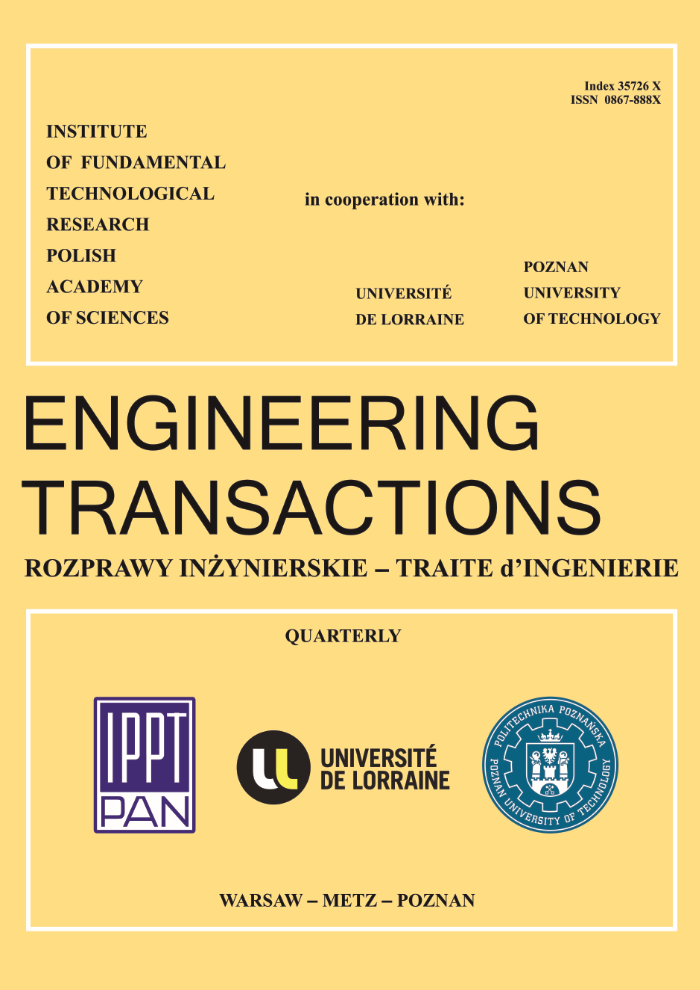Abstract
The paper deals with the numerical homogenization of structures made of non-linear porous material. Material non-linearity causes a significant increase in computational costs for numerical homogenization procedure. An application of the response surface methodology allows a significant reduction of the computational effort providing good approximation precision. Finite element method commercial software is employed to solve the boundary-value problem in both scales. Due to the significant reduction in computing time, the proposed attitude may be applied for different optimization and identification tasks for inhomogeneous, non-linear media, especially with the use of global optimization methods.Keywords:
numerical homogenization, response surface, porous material, non-linear materialReferences
[1] Liu L.S., Chen G.F., Porous materials. Processing and applications, Elsevier, 2014.
[2] Wen C.E., Mabuchi M., Yamada Y.Y., Shimojima K., Chino Y., Asagina T., Processing of biocompatible porous Ti and Mg, Scripta Materialia, 45(10): 1147–1153, 2001, https://doi.org/10.1016/S1359-6462(01)01132-0.
[3] Ishizaki K., Porous Materials: Process Technology and Applications, Springer, Boston, 1998.
[4] Kouznetsova V., Computational homogenization for the multi-scale analysis of multi-phase materials, PhD. thesis, Technische Universiteit Eindhoven, 2002.
[5] Weise T., Global optimization algorithms. Theory and application, 2nd ed., Thomas Weise, Germany, 2009.
[6] Beluch W., Długosz A., Multiobjective and multiscale optimization of composite materials by means of evolutionary computations, Journal of Theoretical and Applied Mechanics, 54(2): 397–409, 2016, https://doi.org/10.15632/jtam-pl.54.2.397.
[7] Beluch W., Burczyński T., Two-scale identification of composites' material constants by means of com-putational intelligence methods, Archives of Civil and Mechanical Engineering, 14(4): 636–646, 2014, https://doi.org/10.1016/j.acme.2013.12.007.
[8] Beluch W., Hatłas M., Multiscale evolutionary optimization of Functionally Graded Materials, [in:] Proceedings of the 3rd Polish Congress of Mechanics (PCM) and 21st International Conference on Com-puter Methods in Mechanics (CMM), Chapter 15, pp. 83–86, CRC Press/Balkema, 2016.
[9] ANSYS 3D DesignXplorer 18.0 software documentation, ANSYS 2017.
[10] ANSYS Mechanical 18.2 software documentation, ANSYS 2017.
[11] Zohdi T., Wriggers P., An introduction to computational micromechanics, Springer, 2004.
[12] Dormieux L., Lemarchand E., Kondo D., Brach S., Strength criterion of porous media: Application of homogenization techniques, Journal of Rock Mechanics and Geotechnical Engineering, 9(1): 62–73, 2017, https://doi.org/10.1016/j.jrmge.2016.11.010.
[13] Fritzen F., Forest S., Böhlke T., Kondo D., Kanit T., Computational homogenization of elasto-plastic porous metals, International Journal of Plasticity, 29: 102–119, 2012, https://doi.org/10.1016/j.ijplas.2011.08.005.
[14] Terada K., Hori M., Kyoya T., Kikuchi N., Simulation of the multi-scale convergence in computational homogenization approaches, International Journal of Solids and Structures, 37(16): 2285–2311, 2000.
[15] Ptaszny J., Fedeliński P., Numerical homogenization by using the fast multipole boundary element meth-od, Archives of Civil Mechanical Engineering, 11(1): 181–193, 2011, https://doi.org/10.1016/S1644-9665(12)60182-4.
[16] Zienkiewicz O.C., Taylor R.L., The finite element method, vol. 1–3, Butterworth, Oxford, 2000.
[17] Czyż T., Dziatkiewicz G., Fedeliński P., Górski R., Ptaszny J., Advanced computer modelling in microme-chanics, Silesian University of Technology Press, Gliwice, 2013.
[18] Hill R., Elastic properties of reinforced solids: Some theoretical principles, Journal of Mechanics and Physics of Solids, 11: 357–372, 1963, https://doi.org/10.1016/0022-5096(63)90036-X.
[19] Nemat-Nasser S., Hori M., Micromechanics: Overall properties of heterogeneous materials, Elsevier, 1999.
[20] Jiang T., Shao J., On the incremental approach for nonlinear homogenization of composite and influ-ence of isotropization, Computational Material Science, 46(2): 447–451, 2009.
[21] Ilic S., Hackl K., Application of the multiscale FEM to the modeling of the nonlinear multiphase materi-als, Journal of Theoretical and Applied Mechanics, 47: 537–551, 2009.
[22] Terada K., Kikuchi N., Nonlinear homogenization method for practical applications, American Society of Mechanical Engineers, Applied Mechanics Division, 212: 1–16, 1995.
[23] Kleijnen J.P.C., Kriging metamodeling in simulation: A review, European Journal of Operational Re-search, 193: 707–716, 2009.
[24] Myers R.H., Montgomery D.C., Anderson-Cook C.M., Response surface methodology. Process and product optimization using designed experiments, Wiley, 2009.
[25] Bradley N., The response surface methodology, PhD thesis, Indiana University South Bend, 2007.
[26] Vapnik V., The support vector method of function estimation, [in:] J.A.K. Suykens, J. Vandewalle [Eds], Nonlinear modeling, Springer, Boston, MA, 1998.
[2] Wen C.E., Mabuchi M., Yamada Y.Y., Shimojima K., Chino Y., Asagina T., Processing of biocompatible porous Ti and Mg, Scripta Materialia, 45(10): 1147–1153, 2001, https://doi.org/10.1016/S1359-6462(01)01132-0.
[3] Ishizaki K., Porous Materials: Process Technology and Applications, Springer, Boston, 1998.
[4] Kouznetsova V., Computational homogenization for the multi-scale analysis of multi-phase materials, PhD. thesis, Technische Universiteit Eindhoven, 2002.
[5] Weise T., Global optimization algorithms. Theory and application, 2nd ed., Thomas Weise, Germany, 2009.
[6] Beluch W., Długosz A., Multiobjective and multiscale optimization of composite materials by means of evolutionary computations, Journal of Theoretical and Applied Mechanics, 54(2): 397–409, 2016, https://doi.org/10.15632/jtam-pl.54.2.397.
[7] Beluch W., Burczyński T., Two-scale identification of composites' material constants by means of com-putational intelligence methods, Archives of Civil and Mechanical Engineering, 14(4): 636–646, 2014, https://doi.org/10.1016/j.acme.2013.12.007.
[8] Beluch W., Hatłas M., Multiscale evolutionary optimization of Functionally Graded Materials, [in:] Proceedings of the 3rd Polish Congress of Mechanics (PCM) and 21st International Conference on Com-puter Methods in Mechanics (CMM), Chapter 15, pp. 83–86, CRC Press/Balkema, 2016.
[9] ANSYS 3D DesignXplorer 18.0 software documentation, ANSYS 2017.
[10] ANSYS Mechanical 18.2 software documentation, ANSYS 2017.
[11] Zohdi T., Wriggers P., An introduction to computational micromechanics, Springer, 2004.
[12] Dormieux L., Lemarchand E., Kondo D., Brach S., Strength criterion of porous media: Application of homogenization techniques, Journal of Rock Mechanics and Geotechnical Engineering, 9(1): 62–73, 2017, https://doi.org/10.1016/j.jrmge.2016.11.010.
[13] Fritzen F., Forest S., Böhlke T., Kondo D., Kanit T., Computational homogenization of elasto-plastic porous metals, International Journal of Plasticity, 29: 102–119, 2012, https://doi.org/10.1016/j.ijplas.2011.08.005.
[14] Terada K., Hori M., Kyoya T., Kikuchi N., Simulation of the multi-scale convergence in computational homogenization approaches, International Journal of Solids and Structures, 37(16): 2285–2311, 2000.
[15] Ptaszny J., Fedeliński P., Numerical homogenization by using the fast multipole boundary element meth-od, Archives of Civil Mechanical Engineering, 11(1): 181–193, 2011, https://doi.org/10.1016/S1644-9665(12)60182-4.
[16] Zienkiewicz O.C., Taylor R.L., The finite element method, vol. 1–3, Butterworth, Oxford, 2000.
[17] Czyż T., Dziatkiewicz G., Fedeliński P., Górski R., Ptaszny J., Advanced computer modelling in microme-chanics, Silesian University of Technology Press, Gliwice, 2013.
[18] Hill R., Elastic properties of reinforced solids: Some theoretical principles, Journal of Mechanics and Physics of Solids, 11: 357–372, 1963, https://doi.org/10.1016/0022-5096(63)90036-X.
[19] Nemat-Nasser S., Hori M., Micromechanics: Overall properties of heterogeneous materials, Elsevier, 1999.
[20] Jiang T., Shao J., On the incremental approach for nonlinear homogenization of composite and influ-ence of isotropization, Computational Material Science, 46(2): 447–451, 2009.
[21] Ilic S., Hackl K., Application of the multiscale FEM to the modeling of the nonlinear multiphase materi-als, Journal of Theoretical and Applied Mechanics, 47: 537–551, 2009.
[22] Terada K., Kikuchi N., Nonlinear homogenization method for practical applications, American Society of Mechanical Engineers, Applied Mechanics Division, 212: 1–16, 1995.
[23] Kleijnen J.P.C., Kriging metamodeling in simulation: A review, European Journal of Operational Re-search, 193: 707–716, 2009.
[24] Myers R.H., Montgomery D.C., Anderson-Cook C.M., Response surface methodology. Process and product optimization using designed experiments, Wiley, 2009.
[25] Bradley N., The response surface methodology, PhD thesis, Indiana University South Bend, 2007.
[26] Vapnik V., The support vector method of function estimation, [in:] J.A.K. Suykens, J. Vandewalle [Eds], Nonlinear modeling, Springer, Boston, MA, 1998.



